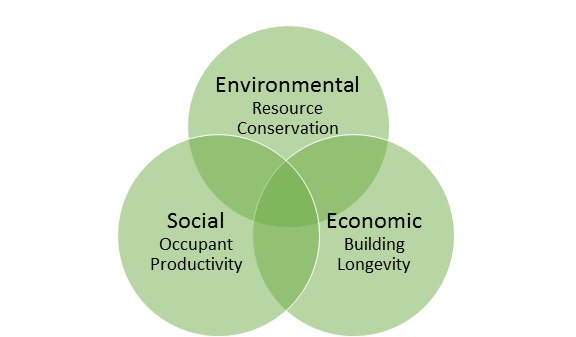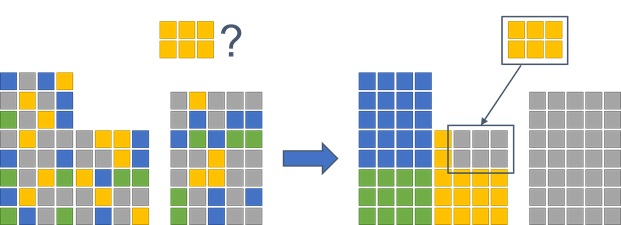December 2017
The case for creating more sustainable facilities is based on the triple bottom line. The triple bottom line teaches us that our actions need to make economic, social, and environmental sense. If we apply the triple bottom line concept to facility and space management, we ask: What are we sustaining?
The connection between facility management and space planning most often brings forth thoughts of the environment – expressed as conserving resources during space moves, creation, and demolition. The economic piece of the triple bottom line suggests that we work toward saving money throughout the service life of a space. Prolonging the useful life of a facility is an example of economic sustainability. Finally, more unique to space management, is the social aspect of sustainability, or the productivity of the building’s occupants. How do we effectively use the space to create a work environment that is safer and healthier for its occupants and more productive in meeting organizational objectives? Figure 1 below illustrates this integrated concept.
Space planning and management involve the transient and fixed elements in the spaces of a building or buildings. The Merriam-Webster dictionary defines a space as “a boundless three-dimensional extent in which objects and events occur and have relative position and direction (Merriam-Webster, 2017).” For facility purposes, we may replace “boundless” with having defined boundaries, whether visible or invisible. Fixed elements include furniture, fixtures, and equipment (FFE) that belong in a space (even if portable/configurable), as well as “permanent” elements such as walls, floors and ceilings. In space planning language, people are considered “transient” since they move into and out of the building. Transient elements also include objects such as warehouse inventory that occupy space temporarily.
Typically in facilities management, we are concerned with a building’s systems, operation, and functionality – the physical as well as the organizational. Space planning is a practice that works hand-in-hand with facilities management and provides opportunities for more sustainable workplaces.
Space Reorganization Scenario Example
Let’s look at an example of space management in practice. Figure 2 below illustrates a scenario in which three different groups – Blue, Yellow, and Green – are arranged between two buildings, with vacant space in grey. In the existing configuration, if the Yellow group wants to add a block of six rooms, there is no space for this block to go. When the space is rearranged, not only can the new Yellow group now fit, but a whole building is left vacant. Many economic opportunities could come from this, such as selling the building, or leasing to another group. Of course, getting people to move to an alternative space is not as easy as recoloring blocks. This brings us to the social aspect of sustainable space management.
Social Sustainability: Occupant Productivity
Occupants in a building are there for a specific purpose, whether for work, as a consumer, or simply a home base. The social aspect of the triple bottom line focuses on the occupants and their well-being in order to optimize productivity in their environment, on whatever their task.
 In the above scenario, social improvements can already be found. By increasing proximity to occupants of one’s own group, less effort will be spent in coordinating collaboration and traveling to meetings and other activities. If interaction among the groups is desired, one can plan a meeting space somewhere in the area outlined in Figure 3 at the right.
In the above scenario, social improvements can already be found. By increasing proximity to occupants of one’s own group, less effort will be spent in coordinating collaboration and traveling to meetings and other activities. If interaction among the groups is desired, one can plan a meeting space somewhere in the area outlined in Figure 3 at the right.
Maximizing productivity leads to occupant efficiency; i.e., when people can perform their tasks at an adequate or greater level within their own space. However, effectiveness is achieved if those same tasks can be improved by collaboration with someone who is now sitting nearby as opposed to in another building.
The health, comfort, and ultimately, productivity of a person are significantly affected by the space they occupy. When renovating a space, using materials that do not emit, or emit only low amounts of harmful chemicals, such as low-VOC paints, and avoiding high emitting ones, like particleboard, will help maintain adequate indoor air quality and occupant health and safety. Ensuring spaces are managed for compliance with fire codes (keeping fire doors clear of furniture, adhering to occupancy requirements, etc.) is another measure to protect their safety.
Mental and emotional health should not be overlooked when considering space use, as demonstrated in the following example in an academic facility. The entrance to a multi-level library is located below grade and the space contains many racks of books. Study space is available in the below-grade floor; however, the space receives no daylight and has an unpleasant odor. Students using the space would likely be more productive on an upper level that has access to daylight, outdoor views, and more adequate ventilation. What could a space planner do to improve the study area? Solutions include swapping the study spaces and book storage, providing more ventilation, and lighting improvements. Lighting improvements might also contribute to the economic and environmental leg of the triple bottom line by saving money and energy.
Economic Sustainability: Building Longevity
When it comes to making decisions about the operation of a facility, cost becomes one of the primary drivers. There are a number of operational costs within space management that are reduced through the optimization of space use. For example, janitorial costs, some utility costs, and some maintenance costs can be eliminated from a vacant building. While a facility manager might look for ways to maximize the building’s longevity, a space manager would look at utilizing existing space to avoid or defer the costs of building new facilities. The following are approaches to accomplish this:
- Add to existing space/increase density
Rearrange space to fit more occupants (within limits of comfort). A large room could be subdivided into smaller offices, cubicles, or an open plan office. A “combi office” is an office/conference room combination that is primarily used as an office but could be used as a conference room while the occupant is away (General Services Administration, n.d.). This would be preferable if the occupant is frequently out of office or travels often. - Reorganize space
The space reorganization scenario shows reorganization of space, moving occupants of similar groups together and eliminating surrounding vacancies to be able to fit in larger groups. - Repurpose space
Repurposing a space involves changing its function. Recently, shopping centers have been repurposing space to re-attract and retain customers, converting big-box and department stores into grocery stores or fitness centers (Reindl, 2017). The new tenants benefit as well, by not having to bear the cost of a new structure. - Reassign space
A space is reassigned when it is determined that an occupant with higher priority needs will occupy the space, and the current occupant is sent to a different space that still meets their needs. Reassignment has its challenges, mostly in how the change is perceived. There is higher risk for conflict and opposition from occupants if they feel as if “their” space is being taken away. - Vacate the space
If it is determined that an occupant is able to work remotely or telecommute, the space may be given up entirely for new use. An office space can be used for “hoteling” or “hot desking,” which allow desks to be temporarily occupied by whomever as needed, with or without reserving them beforehand, respectively (General Services Administration, n.d.). - Increase flexibility/mobility
When repurposing or adding to a space, consider using modular or configurable styles of elements such as partitions, FFE, or lighting. In this way, spaces can be fairly quickly and easily modified to suit the current need.
Environmental Sustainability: Resource Conservation
If renovation or new construction is the chosen option, being mindful of the environmental effects of the renovation can pay off later. In addition to protecting occupant health, the use of low-emitting products reduces the amount of chemicals that negatively affect air and water quality. Choosing renewable and more durable building materials can have a positive effect on the environment by using renewable resources and lengthening service life. Reusing materials in the amount of five percent of the total project materials’ value will earn credits toward LEED certification (USGBC, 2017).
Efficient and effective space planning can help meet organizational goals toward Corporate Social Responsibility (CSR) programs. Cornell University is working toward its goal to “reduce energy (and greenhouse gas emissions) associated with new building construction by reducing the amount of new space required on campus” (Cornell University, n.d.). Cornell’s commitment states, “The overarching goal of the space management function is to develop strategies to enable units to more fully utilize existing space, through re-purposing to higher priority needs, sharing with other units, reallocating to other units, and/or making strategic capital investments to improve quality and functionality.”
Being able to plan space use ahead of time is a significant advantage and can save time, money, and resources. Optimizing occupant distribution and material use in the early stages of a project can save significant costs of operating and maintaining a facility over its life.
Focusing on energy use in new and existing buildings can produce immediate cost savings. Any space reorganization situation that leads to vacancies of entire spaces will produce significant cost reduction opportunities.
Since utility consumption is a large portion of the long-term costs to operate facilities, proper HVAC scheduling can have a significant positive impact on operating costs. A typical office building runs on an 8 AM to 6 PM schedule, while a hospital must be conditioned 24/7. A police station may have the whole building running on a 24/7 schedule while the administrative areas are only occupied during office hours. An energy-saving opportunity thus arises in cutting back operation for those areas.
Zoning, which is strategically sectioning HVAC to optimally condition the assigned zone spaces, presents cost savings opportunities. A proper zoning strategy is key – if a warehouse is divided into two zones but there are no partitions, operating only one of the zones would backfire, as that system would end up overworking itself trying to condition the entire space as the air moves into equilibrium.
In a large convention center, university, or hotel, spaces are assigned to temporary events, each with different needs. Assigning events to the most appropriate space can also reduce energy usage, for example, scheduling a small wedding in the smaller of two ballrooms.
The Space Planning and Sustainable Facility Management Connection
Buildings spaces come in all types and sizes and have many characteristics. A single two-story office building has very different operational requirements and space needs than a university campus with an entire portfolio of buildings. It’s also likely that the organizational approach to managing those spaces is quite different. A university may have a space management team that functions separately from the operational team. The space team may or may not be integrated with facility management functions. Just like facility management, space management is most effective with a solid organizational structure and an effective management team.
Effective space management usually requires the assistance of technology tools that demand large amounts of data. Managing large amounts of space data can be a complicated task. Many data fields overlap between space management and operational data in facility management. The data ideally should be owned and maintained by a designated entity in order to stay current and avoid multiple copies of the same data, whose edits may become hard to track. While system integration has come a long way in making improvements in technology (such as Integrated Work Management Systems [IWMS]), there is always a need for better functional integration. Use of standards, such as Facilities Inventory and Classification Manual (FICM) codes (space types specific to higher education) or ones created specifically for the building(s), can make the job easier.
It turns out that facility management and space management share many of the same goals, objectives, and data. Making the connection between the space management and facility management functions can lead to more sustainable facilities. Incorporating sustainable space management practices can improve an organization’s financial bottom line and help meet the objectives of the triple bottom line.
Sara Ambry is a Project Engineer at Facility Engineering Associates. She graduated from Purdue University with a background in architectural engineering and has particular interest in high-performance building and renewable energy. Sara works under the facility consulting service line and has contributed to projects involving space management and planning and facilities management optimization. She plans to obtain her Professional Engineer license in early 2018.
References
Cornell University. (n.d.). Maximize Space Efficiencies. Retrieved from Cornell Sustainable Campus: http://www.sustainablecampus.cornell.edu/initiatives/space-planning-and-management
General Services Administration. (n.d.). Space Reconfiguration and Renovation Projects. Retrieved from Sustainable Facilities Tool: https://sftool.gov/plan/265/space-reconfiguration-renovation-projects
Merriam-Webster. (2017, December 8). Space. Retrieved from Merriam-Webster: https://www.merriam-webster.com/dictionary/space
Reindl, J. (2017, November 27). Empty big-box retail stores a growing problem (or opportunity) for suburban Detroit. Retrieved from Detroit Free Press: https://www.freep.com/story/money/business/2017/11/27/empty-big-box-stores-michigan/830459001/
USGBC. (2017). Materials reuse: 5 %. Retrieved from U.S. Green Building Council: https://www.usgbc.org/credits/retail-new-construction/v10-pilot/mrc31

